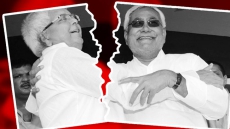The Italy-made “siri sahib” (kirpan) was rejected by Akal Takht today for failing to conform to the Sikh code of conduct.
The five high priests today disapproved of the “replica” of kirpan having a bendable blade and asked the Sikh community living in Italy to seek permission for wearing the original small-size kirpan.
On June 26, a delegation from Italy, including an Italian Sikh activist Sukhdev Singh Kang, had submitted a set of modified kirpan to Akal Takht for seeking its formal approval on wearing it.
Italian delegates Rozy Roberto and El Lorenjo had stated then that since the original kirpan carried by Sikhs in Italy appeared more like a weapon, the authorities came up with this model.
Akal Takht Jathedar Giani Gurbachan Singh had put the matter on hold to discuss it with the five high priests.
He said irrespective of the size, the kirpan was worn as a religious symbol as defined by Guru Gobind Singh under the norm of “panj kakaar” - kesh (uncut hair), kanga (a wooden comb for hair), kara (an iron bracelet), kachera (100 per cent cotton undergarment tied with a string and not an elastic one) and kirpan (an iron dagger large enough to defend oneself).
“Today, after observing the religious aspect, coupled with the suggestions received from the Sikh organisations and experts from all over the globe, the five high priests concluded that the Italian replica of kirpan never conformed to the rehat maryada. Acceptance of this model will have severe and negative repercussions for Sikhs across the world and hence cannot be approved,” he said.
He added, “As far as the ban (on kirpans) imposed by the Italy government is concerned, various Sikh organisations and gurdwara bodies should make joint efforts to ensure that it is lifted.”
‘KIRTAN BY WOMEN UNDER DISCUSSION’
On allowing Gursikh women to perform Gurbani kirtan at the Golden Temple, Akal Takht Jathedar Giani Gurbachan Singh said, “As per maryada, the women are barred from performing kirtan at the Golden Temple.
However, the matter is still under discussion with the five high priests.”




